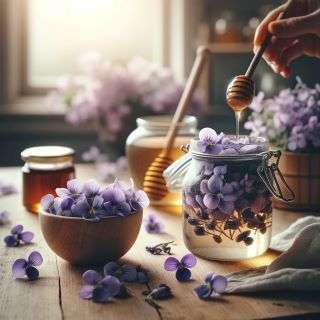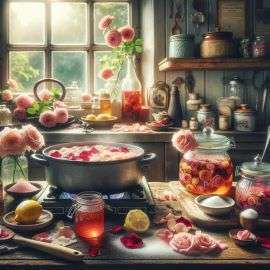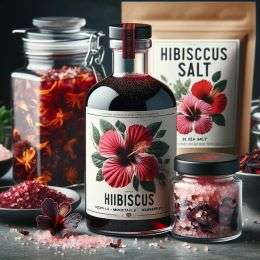This post contains affiliate links, through which we may earn a commission at no additional cost to you.
Table of Contents
Introduction
Dive into a gastronomic expedition where your dish turns into an artist’s canvas, and the hues taste as splendid as they look. In the beautiful world of fresh edible flowers, the fusion of aesthetics and taste elevates ordinary dishes into works of art. We’re revealing the top 10 fresh edible flowers that offer more than a visual treat but a rave for your senses. From the spicy zest of Nasturtiums to the gentle sweetness of Violets, every flower adds a distinct taste to your plate.
Nasturtiums: The Spicy Showstoppers
Nasturtiums are the bold, colorful characters in the edible flower garden, displaying bright colors and a spicy zest similar to arugula. These flexible, fresh, edible flowers are perfect for throwing into salads, adorning savory meals, or filling with creamy cheese for a sophisticated starter. For those interested in diving deeper into nasturtiums, “The Edible Flower Garden” by Rosalind Creasy is packed with recipes and advice for gardening.
- Planting and care tips
- Nasturtiums flourish under the bright sun, yet they can also adapt to some shade, offering flexibility in where you place them in the garden. T
- hey are keen on well-draining soil and have a minimal need for fertilizers; an excess could result in a lush of leaves rather than blooms.
- Seeding them directly into the soil when spring arrives after the frost season or initiating them indoors a month to a month and a half before frost ceases is ideal.
- Ensure they receive steady watering, but guard against overhydration.
- How to Make a Zesty Nasturtium Pesto
- Craft a fiery and colorful nasturtium pesto by blending a cup of nasturtium leaves with some of its flowers, half a cup of either walnuts or pine nuts, one clove of garlic, and half a cup of grated Parmesan cheese in a blender or food processor.
- Gradually add olive oil during the blending process to achieve a creamy texture. Finish with a dash of salt and pepper according to your liking.
- This delightful pesto can be slathered on crusty bread, tossed with your favorite pasta, or served as a lively accompaniment to soups and salads.
Recommended Products
- Olive Oil with Nasturtium Essence
- Seek out this specialty olive oil online to inject nasturtium’s peppery flavor into your dishes. Ideal for a finishing touch on salads, roasted veggies, or simply for dipping bread, it brings a nuanced spiciness and enriches dishes with its distinctive flavor.
- Vinegar of Nasturtium Seeds
- Discover this unique condiment made by steeping nasturtium seeds in either white wine or apple cider vinegar, offering a zesty twist to your culinary creations. Perfect for dressing greens, marinating proteins, or adding an unexpected zing to your sauces.
- Herbal Tea with Nasturtium Flowers
- Explore herbal teas incorporating dried nasturtium flowers for a gentle, slightly spicy beverage experience. These teas blend the edgy flavor of nasturtium with assorted herbs, providing a pleasant way to consume the beneficial vitamins C and A found in nasturtiums in a soothing, hot infusion.
Violets: Soft and Sugary
Violets, known for their gentle aroma and sweet floral flavor, lend a sophisticated flair to sweets and drinks. Imagine sipping on lemonade mixed with violet essence or biting into cupcakes topped with crystallized violets — simply enchanting. Explore “Cooking with Flowers” by Miche Bacher for creative violet recipes that will turn your kitchen into a den of sweet treats.
- Planting and care tips
- Violets are partial to the cooler, moist environs and thrive best under the shelter of partial shade, making them perfect additions to your spring and autumn garden collection.
- They bloom in rich, well-draining soil that’s balanced or slightly acidic in pH.
- Planting them either from seeds or as young saplings as spring commences ensures they have ample time to take root.
- Keeping the soil moist without leading to waterlogging and mulching to retain soil moisture and coolness at the roots is advisable.

- Practical Example: Honey Infused with Violet Petals
- Infusing honey with the essence of violet petals is an enjoyable and straightforward method to capture their delicate essence.
- Begin by carefully rinsing a cup of violet petals under water and drying them softly.
- Next, pack a sterile jar with these petals before covering them with gentle-flavored honey, such as acacia or clover.
- Allow this concoction to rest in a dim, cool area for at least a week, giving it a mix now and then.
- Over time, the honey will adopt a subtle hue and flavor of violet, turning it into an exquisite complement to desserts and teas or as a unique spread on its own.
Product Suggestions
- Tea with Violet Essence
- Crafted from a gentle blend of green tea leaves and dried violet flowers, this tea provides a calming, aromatic indulgence. Ideal for those seeking to relax with a floral-infused cup of tea
- Jam Made from Violet Petals
- This luxurious jam merges the aromatic, sweet taste of violet petals with premium cane sugar, offering a topping perfect for enhancing breakfast pastries, desserts, or even pairing with cheeses.
- Syrup Flavored with Violet
- This adaptable syrup, embodying the essence of violets in a fluid format, is excellent for adding to cocktails, sodas, or topping off sweets. Culinary adventurers eager to introduce a distinct floral flavor to their dishes should take advantage of this.
Lavender: The Fragrant Magician
Lavender goes beyond its use in fragrances to become a gastronomic wonder, adding a distinct aromatic and subtly sweet flavor to dishes. Think of lavender honey poured over a hot biscuit or a lavender-flavored crème brûlée; the options are limitless. “The Lavender Cookbook” by Sharon Shipley is filled with recipes demonstrating lavender’s culinary flexibility.
- Planting and care tips
- Lavender, seeking out full sunlight and favoring well-draining and a bit alkaline soil conditions, does best in the less fertile terrains and faces challenges in moist, dense soils.
- Plant it with the onset of spring, post-frost risks, considering enough space around for air to circulate.
- The key to watering is doing so thoroughly but sparingly, depending on when the soil feels dry, to foster robust root growth.
- A yearly trim shapes them up and encourages fresh sprouts.
- Practical Example: Honey Infused with Lavender
- Indulging in honey infused with the essence of lavender offers a unique method to appreciate lavender’s aromatic and sweet characteristics.
- Start by selecting a jar of honey you prefer and gently heat it using a low flame.
- Incorporate generous dried lavender blooms, ensuring each is wholly soaked.
- Let the concoction steep for about a week, giving it a gentle stir now and then.
- When the taste reaches your desired intensity, remove the lavender flowers.
- This lavender-enhanced honey is splendid for pouring over pastries, enriching your tea, or as a marinade for baked meats.
Product Recommendations
- Blend for a Lavender Essential Oil Diffuser
- Transform your home’s ambiance with a mix designed for diffusers that capture the serene scent of lavender. This concoction is perfect for instilling a sense of calm and ensuring restful sleep, blending lavender’s fragrance with synergistic aromas like chamomile and sandalwood to foster a tranquil atmosphere in your dwelling.
- Tea with Lavender Herbs
- Delve into the tranquil properties of lavender with a steaming mug of herbal tea. This blend, devoid of caffeine and often combined with other soothing herbs such as peppermint or chamomile, is the ideal companion for decompressing at the day’s end, promoting relaxation and alleviating stress.
- Lavender Sugar Exfoliant
- Spoil yourself with a spa experience at home or from a boutique purchase of a lavender sugar exfoliant. This exfoliant is an excellent choice for sloughing away dead skin cells while moisturizing, blending the exfoliative properties of sugar with the calming scent of lavender oil. The outcome is skin that feels silky, rejuvenated, and lightly scented.
Roses: A Melody of Tastes
Roses, the prima donnas of the edible flower realm, captivate with their seductive scent and taste that varies from fruity to zesty. Delights such as rose petal jam, rosewater-laced pastries, and rose tea merely scratch the surface. “Rose Recipes from Olden Times” by Eleanour Sinclair Rohde is a treasure trove for anyone wishing to delve into rose-based cooking.
- Planting and care tips
- Roses bask in no less than six direct sunlight hours daily and require fertile, well-draining ground.
- Enrich the soil with compost before embedding them, and ensure the site promotes good airflow to dodge diseases.
- It’s best to water deeply at the root to prevent leaves from getting wet and inviting fungal infections.
- Early spring fertilization, followed by regular feeding through the growth season, keeps them healthy.
- Pruning when winter wanes or spring begins aids in robust growth and blooms.

- Practical Example: Jam from Rose Petals
- Incorporating roses into your cooking practices can start beautifully with crafting rose petal jam. This delightful jam complements fresh bread and scones or could serve as a sweet addition to teas.
- To make it, you will require fresh rose petals free of pesticides (optimally from aromatic species such as Damask or Centifolia), sugar, lemon juice, and water.
- The method involves simmering the petals softly in sugar and lemon juice, which then evolves into a scented, vibrant-hued jam that bottles the quintessence of roses.
Product Suggestions
- Rose Water
- A key component in the culinary traditions of the Middle East and India, rose water introduces a floral nuance to desserts, pastries, and even some savory recipes. It’s perfect for blending into baklava, rice pudding, or flavoring homemade lemonade for a refreshing change.
- Honey Infused with Rose
- Merging the innate sweetness of honey with the subtle fragrance of roses. This product is ideal for pouring over yogurt, enhancing tea, or as a natural sweetener in baked goods. Honey infused with rose not only lifts the flavor profile of your meals but also adds a romantic flair to your dining experience.
- Tea from Rose Petals
- An aromatic and calming tea crafted from dried rose petals offers an enjoyable caffeine-free drink that can also serve as a foundation for cocktails or poaching fruit, infusing a gentle rose essence into your desserts.
Dandelions: The Misjudged Commoners
Dandelions, far from just being pesky lawn weeds, are filled with nutrients and have a bitter, chicory-like flavor. Their greens blend perfectly into salads, and their flowers can be transformed into jelly, wine, or even fried fritters. “The Dandelion Celebration: A Guide to Unexpected Cuisine” by Peter Gail stands as the ultimate manual for turning this ubiquitous plant into culinary treasure.
- Planting and care tips
- Dandelions, though challenging and adaptable to most soil types, prefer fertile, well-drained soil and enjoy a spectrum from full sun to partial shade.
- They withstand drought conditions well and typically don’t require much care once settled in. Direct seed sowing in the garden during the early spring days is ideal.
- Since dandelions can spread widely, controlling their growth by detaching flowers before seeding is wise.
- Practical Example: Salad with Dandelion Leaves
- Crafting a delightful Dandelion Leaves Salad is a straightforward yet tasty method to integrate dandelions into your meals.
- Start by picking young, soft leaves of dandelion, ensuring that they haven’t been treated with pesticides or chemicals.
- After giving them a good rinse, mix them in a light dressing composed of olive oil, the juice of a lemon, and a hint of honey, along with salt and pepper for taste.
- Incorporate roasted pine nuts and fresh pear slices to introduce a wonderful mix of textures and flavors.
- This salad refreshes and provides a nutritional boost, perfectly capturing the spring season’s essence.
Product Suggestions
- Dandelion Root Tea
- Perfect for individuals keen on enjoying the dandelion’s benefits without gathering them, this tea delivers a soothing, earthy taste that supports digestion and purification.
- Dandelion Syrup
- This syrup, both adaptable and distinctive, can sweeten drinks, be poured over pancakes, or find its way into your baking. It’s reminiscent of honey but with gentle floral hints, offering an exquisite way to sprinkle sweetness across your culinary creations.
- Dandelion Leaf Supplements
- Dandelion leaf supplements stand as a stellar pick for those drawn to the health advantages that dandelion leaf supplements bring but favor simplicity. Provided in capsule form, they simplify the task of adding dandelion’s nutritional value to your daily routine by an easy measure.
Pansies: The Vivid Adapters
Pansies, with their myriad colors and mild, earthy taste, are fantastic for adding a burst of color to any meal. They’re exceptional for decorating cocktails, salads, and desserts. “Edible Flowers: A Kitchen Companion” by Kitty Morse is brimming with ideas for weaving these bright flowers into your dishes.
- Planting and care tips
- Pansies favor cooler temperatures and can flourish under full to partial sunlight, depending on the regional climate.
- They perform best in rich, well-drained soils with a slightly acidic to neutral pH.
- Planting them during the cooler seasons of early spring or fall, ensuring the soil’s moisture without saturation, and using a slow-release fertilizer when growing aid their growth.
- Regular water keeps them happy.
- Practical Example: Edible Pansy Salad
- Incorporating pansies into one’s meals can provide a delightful twist of vibrant colors and a mildly sweet taste, perfect for enhancing any salad. A prime illustration of this is the making of an edible pansy salad.
- Begin with a foundation of assorted greens like spinach, arugula, and kale for the base.
- To add a splash of color and a delicate floral accent, introduce a liberal amount of clean, fresh pansy flowers.
- Throw in a handful of roasted nuts, such as walnuts or almonds, to present a satisfying crunch.
- Dress the salad with a delicate vinaigrette, possibly a concoction of olive oil, lemon juice, a pinch of salt, and a dash of honey to balance the pansies’ sweetness.
Product Suggestions
- Pansy Seed Mix
- Choose a seed mix showcasing various colors and designs of pansies to personalize the look and taste of your garden. Seek out organic and non-GMO seeds to guarantee the safety of consuming these flowers.
- Edible Pansy Petal Preserve
- For those enchanted by the notion of pansies in their culinary repertoire but short on space or time, an edible pansy petal preserve offers a delightful way to savor their gentle sweetness. It’s perfect spread across bread or mixed into yogurt for a floral enhancement.
- Pansy-Infused Honey
- By weaving the fragrant qualities of pansies with natural honey, this product introduces a distinctive flavor booster to teas, pastries, and sauces. It presents an effortless method to embrace the charm of pansies in your cooking without needing cultivation.
Chrysanthemums: The Assertive Bitters
Chrysanthemums, or mums, introduce a slightly bitter, herb-like flavor, splendid for brewing into teas, blending into soups, and adding to stir-fries. Popular in Asian cooking, their strong taste is greatly appreciated. “The Flower Recipe Book” by Alethea Harampolis and Jill Rizzo provides innovative methods for incorporating these and other flowers into both cuisine and décor.
- Planting and care tips
- Chrysanthemums demand well-drained soil paired with plentiful sunlight to showcase their vibrant colors.
- Springtime planting helps them establish well ahead of winter.
- Keep the soil evenly moist, particularly through dry phases, while averting overhead watering to prevent potential diseases.
- Fueling their growth and bloom with a monthly balanced fertilizer from spring till mid-summer encourages flourishing.
- Practical Example: Infusing Salad Dressing with Chrysanthemum Tea
- Enrich your salad dressing by blending olive oil with chrysanthemum-dried petals.
- Begin with gently warming the olive oil below its boiling point before soaking the dried chrysanthemum petals in this heated oil over several hours, allowing the oil to absorb the floral and slightly bitter essence of the petals.
- After straining out the petals, combine the flavored oil with a dash of honey, some apple cider vinegar, and a small amount of salt, crafting a dressing full of flavor that adds an unexpected layer to your preferred salads.
Product Recommendations
- Chrysanthemum Syrup
- Perfect for infusing drinks with a floral and mildly bitter flavor, this syrup is crafted by boiling chrysanthemum blooms with sugar and water until it thickens into a syrup, filtering out the blossoms. It is a flexible addition that can enhance your drinks with complex flavors.
- Chrysanthemum Seasoning Mix
- Merge ground chrysanthemum dried petals with sea salt, garlic powder, and a sprinkle of chili flakes to forge a distinct seasoning mix. This concoction can be dusted over roasted veggies and meats or mixed into marinades, offering a gentle bitterness and flower-like scent that remarkably suits savory plates.
- Chrysanthemum-Infused Olive Oil
- By melding high-grade olive oil with dried chrysanthemum blooms, one can produce an exquisite condiment ideal for a final touch over servings such as pasta, salads, or soups. This olive oil embraces the subtle floral tones and the distinct bitter quality of chrysanthemums, bringing richness and sophistication to straightforward meals.
Marigolds (Tagetes): The Zesty Twists,
Tagetes, or marigolds, boast a citrusy, spicy zest likened to tarragon or saffron, making them incredible in salads, egg dishes, or as a vibrant edible garnish. “Edible: An Illustrated Guide to the World’s Food Plants” by National Geographic is an essential resource for those keen to explore marigolds and other fresh edible flowers.
- Planting and care tips
- Marigolds are straightforward to cultivate, flourishing in the full gaze of the sun and well-drained soil.
- Though they are less fussy about soil quality, they show best results in moderately fertile conditions.
- Planting seeds directly after the last spring frost or starting indoors between four to six weeks before the frost ends is effective.
- Watering at the base rather than the leaves minimizes disease risk. Deadheading spent blooms fosters a continuous display.

- Practical Example: Dressing with Marigold Essence
- Whip up an eye-catching dressing infused with marigolds that adds a unique citrus twist to your leafy greens.
- Start by immersing fresh marigold blooms in a warm blend of olive oil and apple cider vinegar for around 60 minutes to fuse the flavors.
- After straining the flowers out, mix the flavored oil and vinegar with a spoonful of Dijon mustard, a dash of fresh lemon juice, and a touch of honey for sweetness.
- Besides lending a lively flavor to your salads, this dressing introduces a visually appealing hue and a delicate floral hint that will surely capture attention.
Product Recommendations
- Tea Mixtures with Marigold
- Opt for organic tea mixtures that include marigold petals, which offer a bright, lemony essence paired with other herbs. These teas present a memorable taste experience and are known for their soothing and digestive properties, serving as an excellent part of your wellness routine.
- Marigold Petals in Cooking Paste
- Look for specialty cooking pastes that feature marigold petals, a fantastic choice for bringing a fresh flavor profile to broths, casseroles, and marinades. These pastes merge the signature flavor of marigold with assorted spices, providing a simple method to infuse your recipes with a taste of woodland flora.
- Gourmet Oils with Marigold
- Discover gourmet oils enriched with the essence of marigold petals, ideal for adding a finishing touch to your dishes or mingling into dressings and marinades. These oils impart a delicate floral accent to your cooking and enhance the visual appeal of your words with their striking golden color, making your meals stand out.
Calendula: The Soothing Sun
Calendula, often called “pot marigold,” presents a slightly spicy taste and brightens dishes with its golden color. Recognized for its therapeutic qualities, calendula lends to teas and soups as a natural dye. “Healing Foods” by DK Publishing delves into the health advantages of calendula, among other foods that can bolster your diet and well-being.
- Planting and care tips
- Calendula appreciates full sun to partial shade and loves well-drained soil. While tolerant to drier conditions, regular watering promises the best blooms.
- Sowing seeds directly in the garden during spring or autumn and encouraging more blooms by removing faded flowers are good practices.
- Calendula might self-seed, surprising you with new plants the following year.
- Practical Example: Making Calendula-Infused Oil
- Crafting your own oil infused with calendula petals is an uncomplicated process that profoundly integrates the healing power of this bright, sun-resembling bloom into your everyday wellness routine.
- Begin by filling a container with dried calendula flowers, then wholly douse the flowers with a carrier oil you prefer; options include sweet almond or jojoba oil.
- Close the container tightly and let it rest under sunlight for 4-6 weeks, during which the petals release their soothing qualities into the oil.
- After this period, filter out the oil, which can now be utilized as a foundational ingredient for skincare concoctions or applied directly on the skin for its soothing and therapeutic benefits.
Product Suggestions
- Calendula Soothing Healing Balm
- Perfect for treating minor cuts, abrasions, and parched skin, this salve merges calendula’s therapeutic properties with the hydrating powers of various natural oils and butter. It is an essential addition to any household’s first aid collection or can serve as an everyday hydrating solution for delicate skin.
- Calendula Gentle Face Wash
- This facial cleanser incorporates calendula extract, providing a mild yet effective purification that suits the most delicate skin types. It aims to alleviate irritation and diminish redness, making skin feel rejuvenated and peaceful.
- Calendula Herbal-Infused Tea
- Calendula isn’t only beneficial for topical application but also offers internal advantages. Drinking herbal tea infused with calendula petals can aid in calming the gastrointestinal system and boost the immune response. Its gentle, somewhat sweet taste offers a pleasing and healthful drink option anytime during the day.
Hibiscus: The Sour Exotic
Hibiscus flowers, with their deep red appearance and sour, cranberry-like taste, shine in teas, jams, and condiments. Especially hibiscus tea is a delightful drink that can be enjoyed hot or chilled. “Tropical Flowers” by Lizabeth Halliday offers a detailed exploration of cultivating and cooking with tropical flowers, including hibiscus.
- Planting and care tips
- Hibiscus thrives under strong sunlight and in moist, well-drained, organically rich soil.
- While tropical hibiscuses crave warmth, the hardier types can endure cooler temperatures.
- They are best planted in spring or the start of summer to ensure they’re established before colder weather sets in.
- Regular, deep watering during dry spells and a balanced, slow-release fertilizer during their growth period support lush foliage and bright, fresh, edible flowers.
- Following the planting and care tips, you can successfully grow and enjoy these fresh edible flowers in your keyhole garden and kitchen.
- Practical Example: Hibiscus Tea Sangria
- A refreshing and unique take on traditional sangria, hibiscus tea sangria combines the floral tartness of hibiscus with the sweetness of fresh fruits.
- Start by steeping dried hibiscus flowers in boiling water to create a strong tea.
- Once cooled, mix this hibiscus tea with a bottle of white or rosé wine, a splash of brandy (optional), and an assortment of sliced fruits like oranges, lemons, strawberries, and peaches.
- Let it chill for a few hours to allow the flavors to meld.
- Serve over ice for a refreshing drink that’s perfect for warm-weather gatherings.
Product Suggestions

- Hibiscus Flower Syrup
- Ideal for cocktails, mocktails, and desserts, this syrup offers a concentrated burst of hibiscus flavor. It’s perfect for drizzling over pancakes, adding sparkling water for a homemade soda, or creating vibrant hibiscus-flavored cocktails.
- Hibiscus Salt
- A unique blend of sea salt and dried hibiscus flowers, this product is excellent for rimming margarita glasses or adding an exotic twist to your favorite dishes. Its floral tanginess enhances the flavors of seafood, salads, and even chocolate desserts.
- Dried Hibiscus Flowers
- A must-have for any pantry, dried hibiscus flowers are incredibly versatile. They can be used to make teas, infused into sauces, or even rehydrated and added to salads for a tart, fruity flavor. They’re also great for making your hibiscus syrup or incorporating it into baking recipes for a hint of sourness.
Where to Shop for Edible Flowers and Related Products:
• Local Farmers Markets: An excellent source of fresh edible flowers.
• Specialty Grocery Stores: Seek the produce section near the herb aisle for fresh edible flowers.
• Online Merchants: Sites like Gourmet Sweet Botanicals, Marx Foods, and Amazon carry a broad selection of fresh edible flowers and related items.
Conclusion
Starting a culinary voyage with fresh edible flowers invites a universe where taste, color, and invention converge. Whether decorating a cocktail with lively nasturtiums, enriching a dessert with soft lavender, or introducing the sharp notes of chrysanthemums into your meals, these floral treasures promise an exhilarating experience for your taste senses. So, why opt for the mundane when the extraordinary is at your fingertips? Let these ten fresh edible flowers motivate you to whip up dishes as aesthetically pleasing as they are flavorfully surprising.
How could I use fresh edible flowers like nasturtiums in my cooking?
Nasturtiums can be used in many dishes. The flowers make garnishes, really pretty, for salads and desserts. And cocktails? Leaves can chopped and added to salads. Sandwiches? or pesto! For a flavor, that is, peppery.
How could I use fresh edible flowers like nasturtiums in my cooking?
Nasturtiums can be used in many dishes. The flowers make garnishes, really pretty, for salads and desserts. And cocktails? Leaves can chopped and added to salads. Sandwiches? or pesto! For a flavor, that is, peppery.
Can I eat all parts of the fresh edible flower nasturtium plant?
Every component of the nasturtium plant is consumable. The blossoms possess a delightful, zesty taste, whereas the foliage imparts a hot flavor to any meal, and the seed pods, when pickled, can act as an alternative for capers
Are all fresh edible flowers like roses edible?
While all roses are technically edible, it’s best to consume roses that are not treated with pesticides and are grown organically. Some varieties are palatable, with the more fragrant roses generally offering the best flavor.
How can I use roses in my cooking?
Those Rose petals! You use them fresh in salads – yep, as garnish. Or dry them and mix them into sugar or, perhaps, teas. What a glorious harmony!! Rosewater, along with – remember – rose syrup! These are very popular in both the Middle Eastern and Indian cooking cultures.
How do I use chrysanthemums in my cooking?
Chrysanthemum leaves can be used in salads or as a green thing in stir-fries. The flowers are often steeped to make cups of tea, especially in Asian cuisines, and can also be used as garnishes!
General Tips for Eating – flowers that you can eat
Always ensure the flowers you can eat have not been treated with pesticides or chemicals. To eat flowers, start gradually because allergies or digestive issues can randomly occur. Using the flowers can be spicy, so use them sparingly in your dishes! Knowing the difference is so important – even if some flowers that shouldn’t be eaten look like flowers that should be, it’s crucial to be sure!
Lastly, think seriously about pairing your garden shears with a chef’s knife! Always remember to consider the color of the sunset while cooking with chrysanthemums. It’s not related but think about it.








